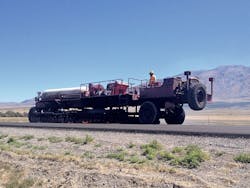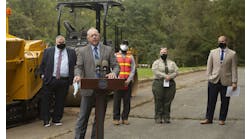In 1942, as the nation plunged headlong into the second world war, the U.S. military opened the Dugway Proving Ground, an installation located 85 miles southwest of Salt Lake City, Utah, for the purpose of testing biological and chemical weapons in a low-drift, relatively contained area.
This area, making up a good portion of Tooele County, comprises, for the most part, much of the western Utah desert. It is, as it was meant to be for its purpose and the work taking place there, isolated and remote.
An ancillary result of this remoteness, decades later, was to make the repair and resurfacing of the only two surface arteries feeding into Dugway—S.R. 196 and S.R. 199—a project of notable difficulty in terms of the application of the Utah Department of Transportation’s (UDOT) commonly practiced mill-and-fill protocol. Something else would be required, something that had not before been employed in UDOT’s history.
“This corridor was chosen for such a uniquely high percentage of recycled asphalt pavement (RAP) for its remote location,” Steven Quinn, project manager for UDOT, told Roads & Bridges. “This location is far out in the desert. It’s an awful long way to haul removed material back and forth, so we went with the recycling. A lot of recycling.”
It’s a good thing they did—because this project earned the 2017 Roads & Bridges/ARRA Recycling Award for the Hot In-Place category.
Out of the norm
“We usually allow 25% RAP in our hot-mix spec,” UDOT resident engineer Rodney Ruby told Roads & Bridges. “On this one, we did 70%. This is the first time we’ve ever done hot in-place. But since it was out in the middle of nowhere, we knew we could get big cost savings on hauling—just for openers.”
Since the only other way into or out of Dugway is a dirt road, S.R. 196/199 was a priority project for UDOT. S.R. 196 shoots in a line directly north from the proving grounds, while S.R. 199 meanders off to the northwest through a mountain pass before meeting with S.R. 36, the next major corridor outside the project site, some 30 miles away.
“The entire project was kind of a big ‘L’,” Quinn said (see Figure 1 on pg. 20). “199 is about 30 miles, and we went 24 miles up 196, which itself is only 34 miles out of Dugway.”
Ruby agreed, saying, “Basically we went as far as the money would allow us.”
And the money was certainly there to be used. Out of a $11 million overall project cost, $9.5 million was allotted exclusively to construction, the remainder being earmarked for public awareness programming, signage, striping and other secondary requirements.
Figure 1. An outline of the project limits. (Image source: UDOT website)
Making progress
Both S.R. 196 and S.R. 199 are two-lane roads. Project planners knew from the get-go that progress could easily be measured in lane-miles per day. This also became a necessary measuring stick, as closure of any portion of either corridor for longer than it would take to mill, pave and compact would place a difficult hamper on traffic going to the proving grounds, as well as the truck traffic that is seen regularly on 196, due to a landfill located adjacent to an Indian reservation. Forcing an unnecessarily prolonged traffic-control situation was assuaged by tactical strategies in planning out the paving train and timing the delivery of new hot mix that would provide a fresh driving surface over the lift of recycled materials.
The project plans called for the milling and replacement of 1.5 in. of the old road, over which a 1.5-in. layer of new hot-mix asphalt (HMA) would be placed—all in a single pass by a single, dual-screed machine. The new HMA was being granite-batched in a plant outside Saratoga Springs, making for a long-haul that required strict logistics in order to get the material in without losing heat or time.
“It was about a two-hour haul with that new HMA,” Todd Gonser, regional sales manager for Cutler Repaving, told Roads & Bridges. “And it was a bit longer to get all the way out near the Dugway. We were tarping our loads to keep the heat from going down, and using what we call a double-double: The first truck holds about 20 tons and the back pup trailer behind holds about 12-14 tons. So loads were coming out large and tarped. As a result, we didn’t have any problems with thermal segregation. And it went over 100°F pretty much every day we were out there, so that worked in our favor as well. We chocked that one up to Mother Nature. The material went right from the truck into the hot [preheater conveyor vehicle] PCV and was immediately laid down. No heat loss from it sitting on the road.”
Propane heaters were employed to prepare the existing degraded surface for milling.
A long train
The paving train arranged for both corridors was crucial to making the sort of progress crews were able to make. Cutler Repaving, which was subcontracted by Granite Construction (the prime), uses custom-made machines on all its projects, in consequence of which they were able to plan a train they knew would fit the bill.
Two R-2000 propane heaters heated up the old, degraded asphalt road, after which Cutler’s R-2400 PCV using hot-air technology to heat up the pavement as it was milled, took up the 1.5 in. of old surface. The emulsion employed for the 620,762 sq yd of RAP saved on the entire project was an HFMS 2P binder.
Once the RAP was milled, mixed and ready, an R-2600 dual-screed repaver—“our workhorse,” Gonser said—laid it back down in its original 1.5-in. lift, which was then immediately followed by a 1.5-in. top lift of the new HMA, which was loaded directly into the R-2600 and laid down by the secondary screed not 2 ft behind the first. The HMA used was a UDOT standard 0.5-in. aggregate with a PG 64-34 binder, heated to approximately 315°F. All told 69,000 tonnes of HMA was produced and placed on the project.
In order to get each 1.3-1.5 miles of road open at the end of every work day, compaction took place immediately after the laydown. A Dynapac CC2200 double-drum vibratory roller in breakdown mode did 1.5 passes, followed then by an Ingersall-Rand PT-125R pneumatic roller at the same rolling pattern. A lighter version of the CC2200—the CC4200—brought each section of road to completion with a single finishing pass.
“We didn’t have any problems with density,” Gonser said.
Tight turns
“When we went up over Johnson’s Pass, the curves got too sharp to recycle,” UDOT pavement engineer Jason Simmons told Roads & Bridges. “The paving train was quite long and the equipment could not make the curves. So that stretch had a standard 3-in. mill-and-fill.”
Johnson’s Pass represents an approximately 5-mile gap in the otherwise consistent use of RAP on the S.R. 199 portion of the project. And while it was not a particular challenge for UDOT or its contractors, all were remiss in that the recycling process could not proceed due to environmental restrictions.
“That mountain pass has turns that are incredibly tight, and some of the equipment was 60 ft long,” Quinn said. “We just couldn’t get it in there to repave the way we wanted to.”
There was, however, a grace note attached to their having to employ traditional techniques for Johnson’s Pass. The material they ripped out and removed was not hauled away.
It was hauled back out to 199 and put to use.
Crews check the progress on the paving train, which was led by a pair of propane heaters that allowed the R-2400 preheated conveyor vehicle to get the material immediately ready for reclamation, mixing and reapplication.
Broad shoulders
“For the shoulders on 199, we did something we’ve never done before,” Quinn said. “We took the milled pavings from the Johnson’s Pass section and used those as sections of new shoulder on the rest of the stretch and then compacted it. So when they came through for milling and relay, they pulled that material in as recycled material and then laid the new asphalt on top of that. The result was that where there were shoulders we added 3 ft but had them only recycle 2 ft of it, so we didn’t have material slipping out of the machine and not being processed.”
The truck traffic resulting from landfill access on 199 was attributed to the rapid decline of the road’s shoulders.
“Unfortunately, they didn’t have enough material to do 196 too,” Ruby said. “But the shoulders on 199 were rounded and falling off. Truck traffic in the area was breaking it off. In some areas we didn’t even have shoulder stripes because it was breaking off so badly. The hope was to eliminate that by widening the shoulders out. The shoulders were the biggest challenge for us, I would say. That shouldering issue was the biggest one. We had to put in a significant amount of base to get that 2-ft wide-out. But we did.”
Why not do that again?
Ruby maintains a degree of skepticism about how hot in-place could function in more urbanized areas—“It’s a slow, slow walk pace, not so good for populated areas”—but his opinion of its applicability in the remote desert landscape that makes up the bulk of his Region 2 purview is solid.
“We’ll need to keep quality controls in place,” Ruby said. “Just to make sure we’re getting what we want, but I love the idea of it. For remote areas, it’s perfect. We couldn’t hold the contractor to UDOT’s smoothness requirement because I didn’t think it was possible. After all, it’s the same standard we require on a new road but this was in such horrible shape to begin with, and with the significant amount of recycling, we weren’t going to be able to meet that. But the contractors did a before-and-after IRI on the project and a 60%-80% improvement was marked. It didn’t meet a new road, but it did significantly improve the ride. So, it’s something we’ll be looking at in the future.”


